Ford Station Wagon Generations: Through the Years
From the Model T version to a separate lineup and all the counterparts in between, we’re looking at the many Ford station wagon generations!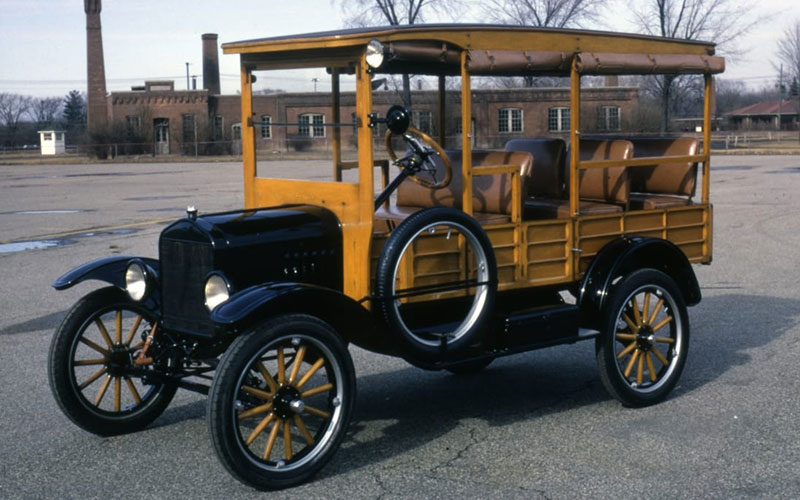
Ford’s Earliest Wagons
Station wagons may mostly be a thing of the past, traded in for more versatile SUVs, but models are still on the market: the 2023 Audi A6 Allroad, 2023 Audi RS 6 Avant, 2023 Mercedes-Benz E-Class wagons, Volvo V60 Cross Country, and V90 Cross Country. Several defunct models made lasting impressions, too, including the Oldsmobile Vista Cruiser, Chrysler Town and Country Wagon, Mercury Commuter, and Buick Roadmaster.
If we’re talking about U.S. station wagons, though, Ford is the place to start. Not only does Ford have some of the most famous wagons, but it also has some of the very first wagons available. Independent manufacturers were creating custom wooden bodies using the Ford Model T chassis as early as 1910.
Initially used as taxi cabs near train depots, the earliest station wagons were commercial vehicles, but companies like Essex Closed Coach and Star eventually offered production models. Ford wasn’t about to be left out. Since Henry Ford owned a hardwood forest in Michigan’s Upper Peninsula, he was able to make Model A wagons at a lower cost than his competitors. By 1929, Ford was the biggest producer of station wagon chassis. As you’re about to find out, the Ford wagons evolved from there, offered as a body style on some of Ford’s most famous models.
1930s Ford Station Wagons
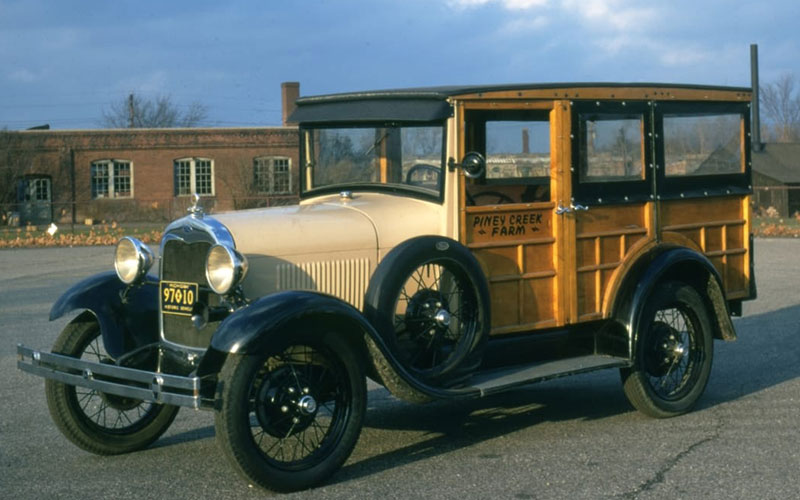
- Wood was mostly used on Ford interiors prior to the arrival of the 1930 wood-bodied station wagon in April 1929. It was the first “Big Three” automaker to offer a factory-built wagon, and used maple, birch, and basswood on different parts of the vehicle.
- The Ford woodie wagon was priced at $625 in 1930, one of the most expensive Ford models at the time and second only to the 1930 Model A town car that was selling for $1,200.
- Original Star woodie wagons had a wooden body, which allowed for more room, a bench seat up front, and additional seats in the back. Ford woodies were similar, accommodating larger families without making anyone sit in the bed of a pickup truck.
- Ford also had a Model B station wagon. It had a 3.29L, four-cylinder engine that made 50 horsepower.
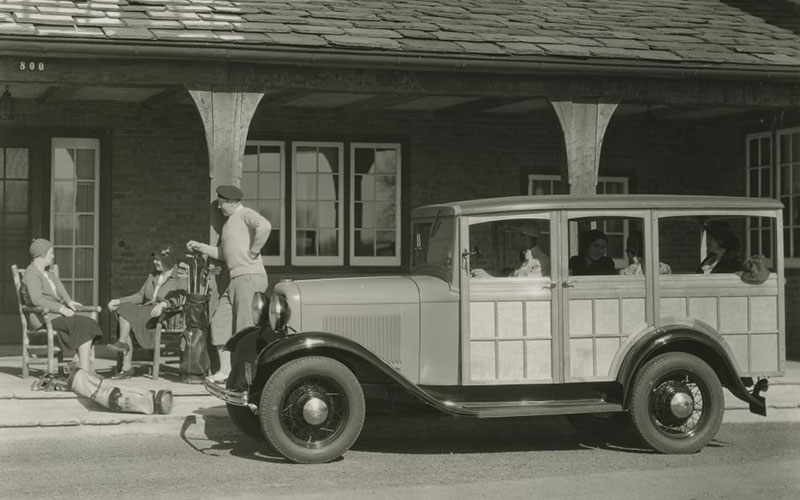
- The 1932 Model B had a starting price of $410, which was less than other Ford models, but people were more interested in more horsepower on vehicles like the 1932 V8 Model 18.
- By the mid-1930s, Ford was charging $755 for some woodie station wagons.
- With wood being supplied from the entire mountain that Ford owned, Ford opened a wagon manufacturing plant in Iron Mountain, Michigan in 1936. Entire wooden bodies were sent to Ford’s assembly plants throughout the continent.
- Ford updated its engine offerings in 1937, adding an entry Level 2.23L V8 to their lineup alongside the 3.62L flathead V8. The new V8 had 60 or 85 horsepower.
- Other updates on all body styles gave a more rounded look to the body, more of a V-shaped grille, and headlights with fairing on the front fenders. All of this was available on a 1937 Model 78 Deluxe station wagon version which fit eight passengers.
1940s Ford Station Wagons
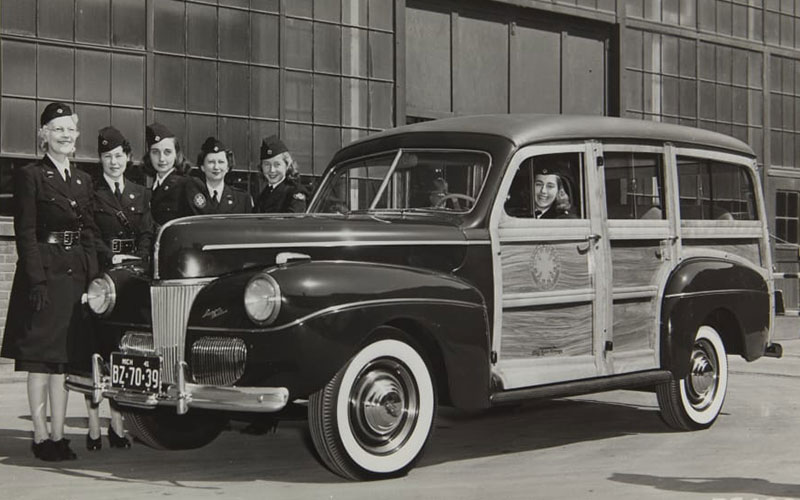
- Ford had continued success with their station wagons going into the 1940s. The 1941 Ford V8 Deluxe woody wagon was the first factory-built Ford of any kind that was priced at over $1,000.
- The 29 millionth Ford vehicle ever produced was a Ford Super Deluxe station wagon. It rolled off the assembly line on April 29, 1941, and was donated to the Detroit Red Cross Women’s Motor Corps.
- Automobile production officially halted on February 2, 1942, during World War II.
- In January 1945, one Ford designer took on a request from Henry Ford II as a personal challenge. When Ford asked for a custom vehicle that he could use around his summer home, Bob Gregorie chose to take an unsold 1931 Model A, gather some extra unused parts, and unrestricted wartime material to create a one-of-its-kind wood-bodied Estate Wagon.
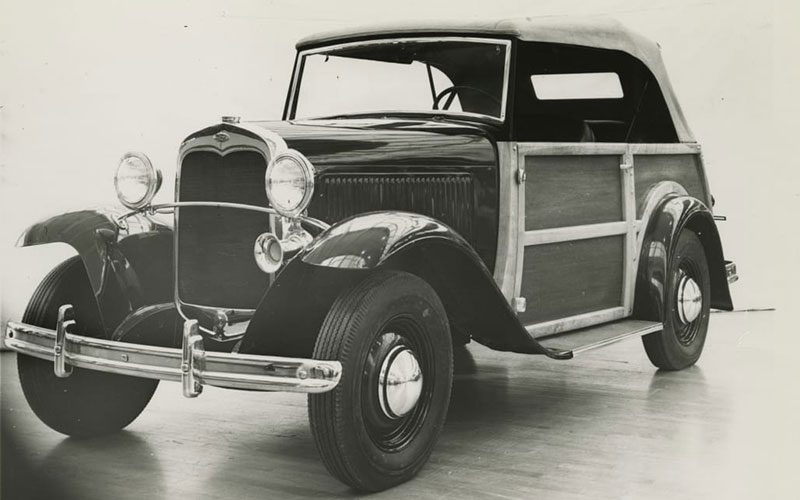
- After the war ended in 1945, the Ford station wagon was one of the first vehicles that was brought back as 1946 models.
- The 1946 Ford station wagon was arguably the most popular Ford in the late 1940s. The Super Deluxe trim was the most expensive trim, so that one didn’t sell as well as others.
- The Deluxe was offered with a V8 at first, but a six-cylinder motor was added later in the same model year. Ford sold 16,920 models that were priced at $1,422.
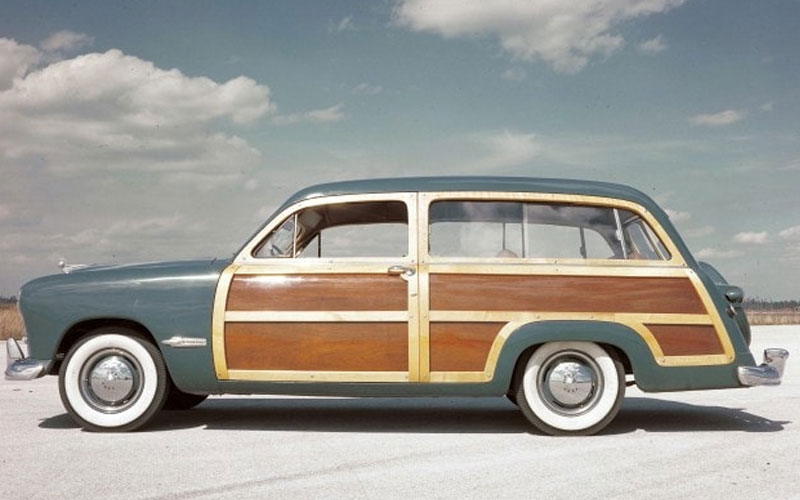
- The Ford station wagons underwent a big change with the introduction of the 1949 Ford Custom (later known as the Country Squire).
- This new design, the result of Eugene Gregorie and Ross Cousins’ combined efforts, marked a transition away from the traditional woodie wagon. Steel was used for the roof, rear fenders, and tailgate frame while wood was kept on the side of the body. This body was shared with Mercury.
- It was positioned as the top-level station wagon for Ford, which marketed the steel elements as safer. Ford advertised it as, “a heart of steel, wrapped in luxury.”
- Listed at $2,119, the Country Squire only had two doors, but three seats offered enough room for eight passengers. It was equipped with a 95-horsepower 3.6L inline-6 engine and a three-speed manual transmission. A 100-horsepower 3.9L flathead V8 was also available.
1950s Ford Station Wagons
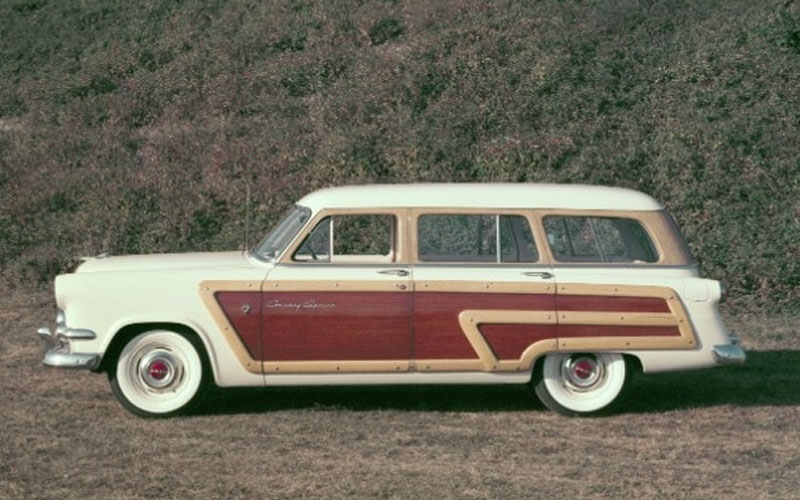
- For the 1950 model, Ford adopted the “Country Squire” name. That wasn’t the only change. The Squire was given a reinforced rear-suspension, wider tires, and a larger fuel tank than Ford sedans.
- An innovative redesign of the 1950 Country Squire allowed second and third-row seats to be removed without tools, making it easier to adjust cargo and seating space.
- Although wood was still a popular design, Ford started phasing out more of the actual wood materials. In April 1950, the lower tailgate was changed from all wood to steel.
- Building the Country Squire was a labor-intensive effort. The initial assembly was done at the Dearborn Assembly Plant. Once that was completed, the incomplete vehicle was shipped to the Iron Mountain plant where wood paneling was fitted. From there, the vehicle was shipped to other Ford factories and placed on assembly lines for final mounting and fitting.
- 1951 Ford station wagons were outsourced to Ionia Body Company, which also assembled wood-bodied station wagons for General Motors.
- A three-speed Ford-O-Matic automatic transmission became available with the 1951 Country Squire station wagons.
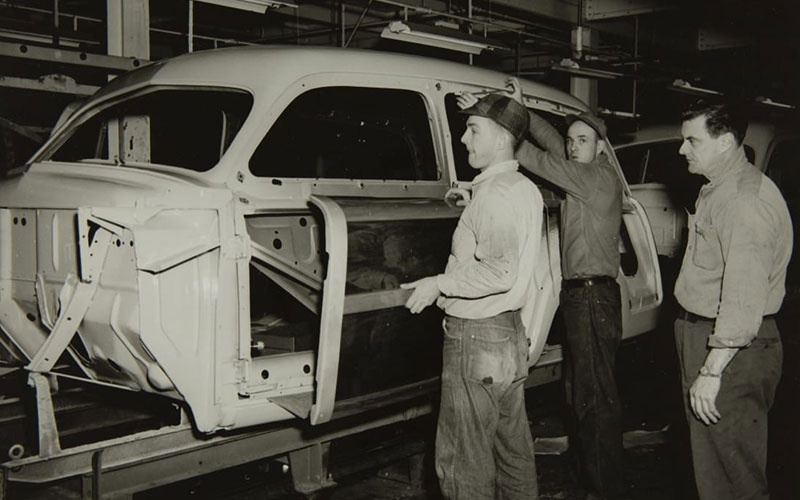
- The second generation of the Country Squire started with the 1952 model and lasted through the 1954 model. This new generation came with more changes. Much of the body was shared with the new Mercury Monterey, though the wheelbase wasn’t shared, and the Country Squire still had wood paneling.
- Ford went all in on station wagons during the 1950s, introducing station wagon counterparts for every sedan line. The Crestline sedan had the Country Squire, the Customline had the Country Sedan, and the Mainline had the Ranch Wagon.
- The 1952 Ford Country Sedan had plain body sides and more modest equipment, making it a more affordable, popular option than the top-tiered Country Squire. As a result, the Country Sedan outsold the Country Squire every year it was produced.
- The first generation of the Country Sedan and the Ford Ranch Wagon started with 1952 models, which was also the start of the second-generation Country Squire.
- That station wagon gained another inch in the wheelbase but was reduced by almost 10 inches in overall length. Two doors were added to the 1952 Country Squire, and the spare tire was moved from the tailgate to under the loading floor.
- 1953 Country Squire models came with commemorative badging on the steering wheel to celebrate Ford’s 50th Anniversary. Rear-door armrests became standard on the same model. Power steering was optional.

- Color options doubled from six to twelve for the 1954 Country Squire. More powered features, like power brakes and a power-adjusted front seat, were introduced that same year.
- The 1955 Country Squire started at $2,392. Ford made a total of 209,000 station wagons that year.
- There were more revisions on the third-generation 1955 Country Squire and the second-generation Country Sedan. You start to notice modern styling elements like tin fails, along with bolder body colors. The Country Squire badging was moved from the front door to the back of the vehicle.
- The biggest change, however, was that Ford moved its station wagons to their own series. Even though the Country Squire was a counterpart for the Fairlane sedan when the Crestline was discontinued, the Country Squire, Country Sedan, and Ranch Wagon were consolidated into a separate station wagon lineup.
- The Country Squire was the flagship wagon with wood paneling, the Country Sedan was in the middle with four doors and no wood paneling, and the Ranch Wagon was a two-door option.
- Ford introduced even more wagons the following year. The 1956 Ford Parklane was a premium station wagon combining the two-door body of the Ford Ranch Wagon with trim elements of the Ford Fairlane sedan. Production only lasted a single model year.
- The 1956 Country Squire and 1956 Country Sedan received a new grille with rectangular turn signals and parking lights. An upgraded 12-volt electrical system provided additional starting power and the introduction of optional air conditioning.
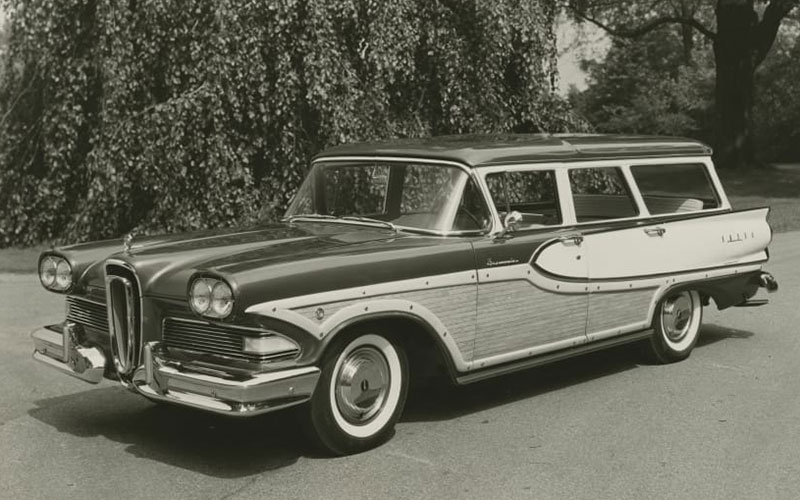
- The 1957 model year introduced the third generation of the Country Sedan and the fourth generation of the Country Squire. Meanwhile, the Ford Ranch Wagon was still a first-generation wagon.
- This was the first time the Country Squire went through a complete redesign. To align with other car manufacturers, Ford reduced the body height of the Squire. An all-new chassis expanded the width of the vehicle, allowing for up to nine passengers in the vehicle for the first time.
- A 144-horsepower 3.6L inline-6 was standard on the revised 1956 Country Squire. A 212-horsepower 4.7L V8 was another option. A 5.1L V8 came with a four-barrel making 245 horsepower, a dual four-barrel making 270 horsepower, or a dual four-barrel supercharger making 300 horsepower.
- The 1957 Ford Del Rio was added to the Ranch Wagon model line, too, replacing the Custom Ranch Wagon and the Parklane. At the same time, the Mercury division of Ford was making station wagons like the 1957 Mercury Villager.
- Even more station wagons were introduced the next year. The 1958 Ford Edsel Bermuda Station Wagon was part of the Edsel line. With faux wood panels and frames, the Bermuda wagon was the top station wagon for the Edsel. Although the Edsel lasted three years, the Bermuda wagon only lasted for one year.
- After a few powertrain revisions on the 1958 Country Squire, the 1959 Country Squire grew more than five inches in length. Even with more power and space in the Country Squire, the 1959 Country Sedan outsold it, reaching a sales peak with 123,412 units sold.
1960s Ford Station Wagons
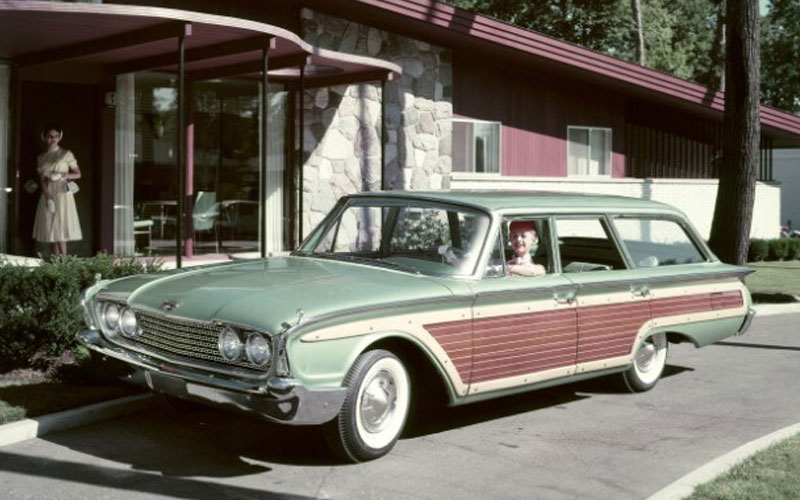
- Fifth-generation Country Squires and fourth-generation Country Sedans started with the 1960 models. The Country Squire was still the mainstay of Ford’s station wagons. It was the counterpart of the new Ford Galaxie, slotted above the Ford Fairlane.
- Another complete redesign resulted in the 1960 Country Squire using a 119-inch wheelbase, which was shared with other full-size Ford models. Longer springs were implemented on the rear leaf suspension to improve handling. The front suspension used a double wishbone configuration.
- Though the 1960 Ford Country Squire was redesigned, it still used engines from the previous generation.
- The 1960 Ford Falcon, available in two and four-door station wagon designs, was another addition to the lineup. It had a unibody construction, a lightweight 2.4L 95-horsepower straight-six engine with a single carburetor.
- A three-speed manual column shift was standard on the 1960 Falcon, but a two-speed Ford-O-Matic automatic transmission was optional.
- The introduction of the Falcon was a result of smaller foreign station wagons also on the market.
- All 1961 Ford station wagons received a new tailgate that was much more functional. The new 1961 tailgate used a self-storing window that could be rolled down with an outside crank or an electric-powered interior switch. Before the 1961 model year, a two-piece tailgate required car owners to lift the rear window and lock it into place before being able to access the rear compartment.
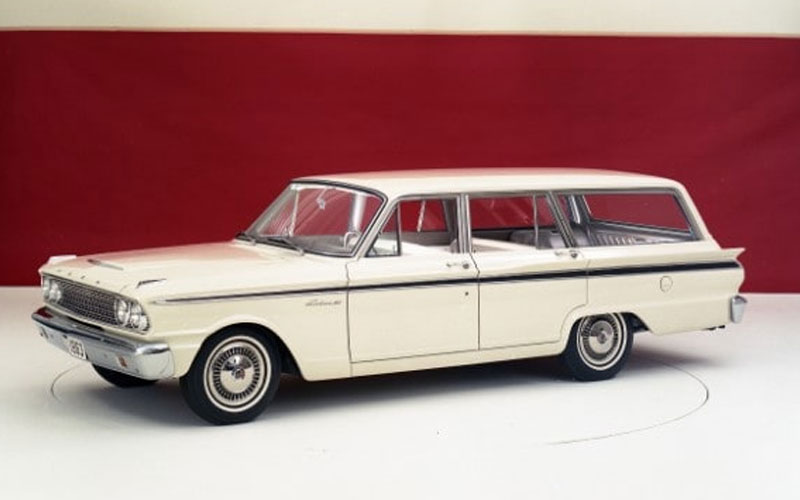
- Ford eliminated two-door options from the full-size station wagon lineup, too. The 1961 Ranch Wagon was strictly available as a four-door model for the first time.
- More wagons were introduced with the 1962 Ford Falcon Club Wagon and Deluxe Club Wagon.
- The 1963 Ford Ranch Wagon kicked off just the second generation of the wagon, though this generation didn’t last nearly as long as the first one had. The second-generation Ford Ranch Wagon was produced for the 1963 and 1964 model years.
- Despite being used for the intermediate-sized Fairlane series, the second-generation Ranch Wagon wasn’t offered on any of Ford’s full-size vehicles.
- The 1963 and 1964 Ranch Wagons ran on a 3.2L six-cylinder engine or one of three V8 engines: a 3.6L, a 4.26L, or a 4.7L.
- Even more station wagons were available now as a Futura and Deluxe wagons
- Another new generation of the Country Squire, another complete redesign. The sixth-generation 1965 Country Squire was given a new chassis. The rear-wheel drive 1965 Ford Chassis remained its 119-inch wheelbase, but frame rails this time around were fully boxed. The front track width expanded for better handling, too. A Three Link coil-sprung solid rear axle replaced the rear leaf springs.
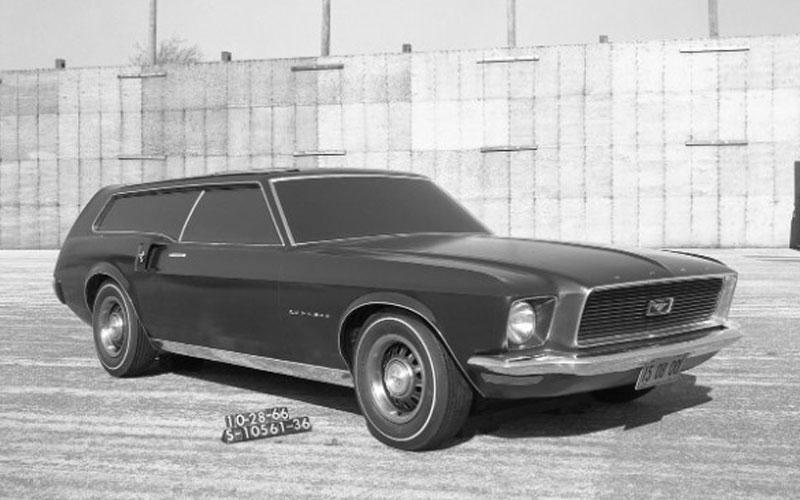
- Under the hood of the 1965 Country Squire was a newly standard 3.9L inline-6 making 150 horsepower. Ford kept all three optional V8 engines from the previous generation. The ‘65 Country Squire engines were mated to a three-speed column-shifted manual transmission or a four-speed overdrive manual.
- Though the roofline was shared with the 1965 Mercury Colony Park, the 1965 Country Squire used different bodywork below the window lines. Vertically stacked headlamps and an enlarged grille were used for the Country Squire.
- 54,810 units of the sixth-generation Country Squire were produced. Meanwhile, Ford sold 92,037 units of the fifth-generation 1965 Country Sedan.
- The third-generation 1965 Ranch Wagon marked a return to the full-size line. This time, it was based on the Ford Custom.
- The 1966 model year was impactful for Ford. It was the year the Ford Bronco was introduced. For more than 10 years, the Bronco had three body configurations. One was a two-door wagon. The other two were an open-body roadster and half-cab.
- Even more changes came with other 1966 Ford station wagon models. The “Magic Doorgate” had arrived. This doorgate was unlike others that had retracting rear glass. The new design, engineered by Donald N. Frey, allowed the rear glass to stay in place when the door opened.
- Drivers no longer had to lower the window of the gate just to access their cargo area. Hinges on the driver’s side of the vehicle provided exactly what was needed to support the weight of the tailgate when it opened.
- 1966 Country Squire also added two versions of the 6.3L V8 engine: one making 275 horsepower and another making 315 horsepower. Plus, for the first time ever, a 7.0L V8 was offered. It made 345 horsepower.
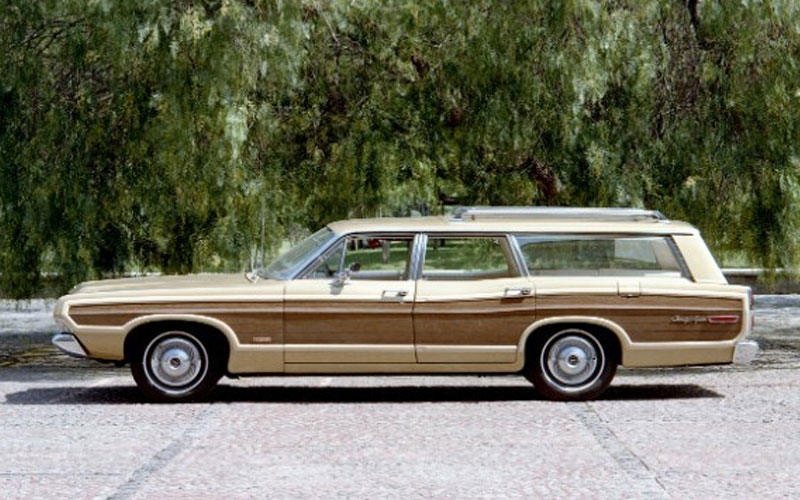
- Some innovations, like the Magic Doorgate were implemented, but other designs didn’t even make it to production. Ford designers drew up a 1966 Mustang station wagon that never got past the concept stage. It was based on a 1966 coupe.
- The Ranch Wagon station wagon debuted two new models in 1968: the Custom 500 Ranch Wagons. There was a six-passenger model and another, regular Ranch Wagon but with third-row seating.
- When the Ford LTD became a full model line, the 1968 Country Squire became its station wagon counterpart.
- While the 1969 Ranch Wagon was still in its third generation, the 1969 Country Sedan started a sixth generation, and the 1969 Country Squire began a seventh generation.
- Sedans and station wagons were no longer separate model lines, so the 1969 Country Squire was given LTD hood badging, the Country Sedan was assigned the Galaxie as a counterpart, and the Rand Wagon partnered with the Ford Custom 500.
- The Country Squire rode on a 121-inch wheelbase, up two additional inches from the previous model year.
- 1969 Ford station wagons were also given an updated “Magic Doorgate.” This time the tailgate could swing down or could swing open, window up or window down.
1970s Ford Station Wagons
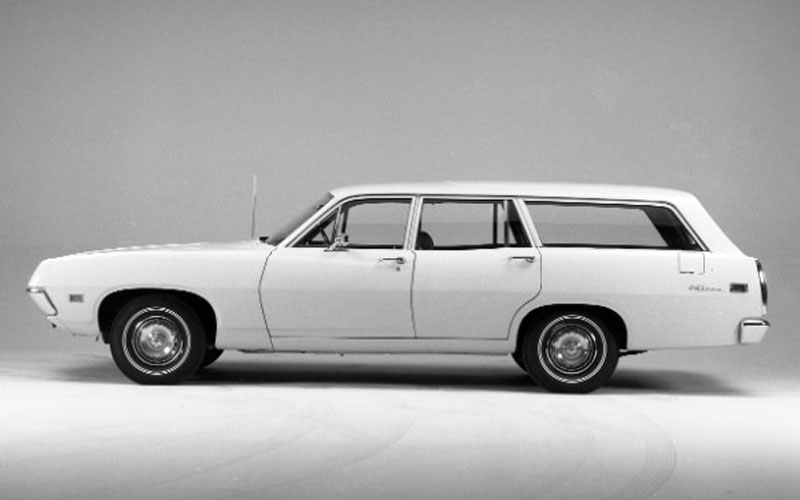
- The 1970s would start a slowdown phase for station wagons, but sales were still strong in the early part of the decade. Ford sold 108,914 of the 1970 Country Squire six and 10-passenger models.
- During the second half of the 1970 model year, Ford presented a new Falcon for the final time. This 1970 ½ Falcon wagon (also shared with the Fairlane and the Torino) had three-point outboard seatbelts and a locking steering column.
- The 1970 ½ Ford Falcon station wagon was the cheapest Ford intermediate car with minimal convenience options, but the station wagon versions of the 1970 ½ Falcon were the only body style that came with power windows.
- The powertrain on the 1970 ½ model ranged from 155 horsepower from a 4.0L inline-6 to 370 horsepower produced by a 7.0L Cobra Jet V8.
- The Ford Torino nameplate was used across the entire intermediate lineup for 1971 models. Both the Falcon and Fairlane names were officially retired.
- Meanwhile, after minimal bumper and grille changes on the 1970 Country Squire, Ford gave the 1971 Squire a pretty large facelift. Just the roof and tailgate were carried over from the previous year. The 6.3L V8 from previous Country Squire models was replaced by a 6.5L V8 on the 1971 Country Squire.
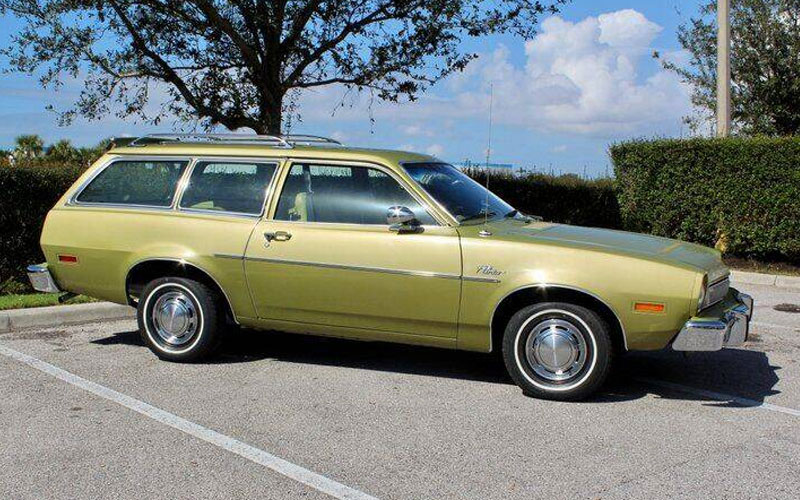
- Another Ford station wagon became available in the form of a 1972 Ford Pinto. The Pinto went on sale in September 1970 as a 1971 model year. Ford recalled several of the initial Pintos because of various manufacturing issues, but they forged ahead with the 1972 Ford Pinto station wagon.
- The ‘72 Ford Pinto was the first two-door station wagon since the 1965 Ford Falcon. It was fitted with a 2.0L engine that made 86 horsepower.
- The horsepower on several 1972 Country Squire powertrains was reduced due to new United States emissions regulations. The range-topping V8 that was making 365 horsepower on 1971 models dropped to 212 horsepower on 1972 models. However, Ford did add a 224-horsepower 7.5L V8 which had been previously used in the Lincoln lineup.
- 55,238 units of the 1972 Country Sedan ended up being made. Since Ford discontinued the Galaxie, they rebranded the Country Sedan as the Galaxie 500 Country Sedan.
- The ‘Custom’ part of the Custom 500 Ranch Wagon names was dropped for the 1973 lineup. The 1973 Ford 4-door sedans and station wagons became pillared hardtops with frameless door glass, roofline enforced by metal B-pillars.
- More regulations from the United States National Highway Traffic Safety Administration (NHTSA) forced Ford to install new bumpers that were dubbed, ‘5 mile per hour bumpers.’
- Larger bumpers added an extra six inches to the 1974 Ford LTD Country Squire. The result was the longest and heaviest station wagons in Ford history along with sales that went from 142,933 units in 1973 to 64,047 units in 1974.
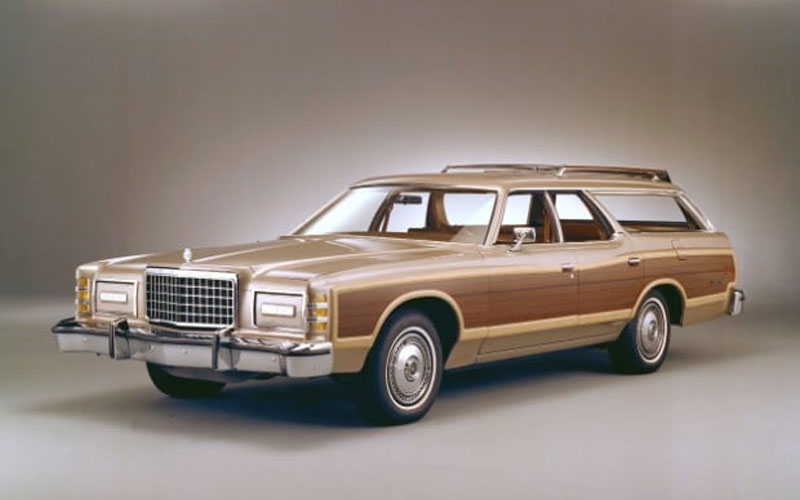
- The 1975 Galaxie 500 Country Sedan was rebranded as the LTD wagon (without any wood), so the Country Sedan didn’t really exist after the 1974 model year. The 1975 LTD Country Squire was given hidden headlamps to help distinguish it from the LTD wagon.
- Catalytic converters were standard in all 1975 Ford models thanks to new emission regulations. By the time the 1975 Custom 500 Ranch Wagon was released, it was almost exclusive to fleet sales in small quantities.
- 1977 Ford Pinto models received a styling update that included new headlamp buckets and chrome bumpers with black urethane end caps.
- There were virtually no changes to the LTD Country Squire, or Ford’s other wagons, until Ford revamped its engine options in 1978 as a way to improve fuel economy. Full-size Ford sedans and wagons were given the returning 5.7L Windsor V8.
- The 1978 Country Squire was given a 400 V8, which was a 6.5L Cleveland engine that produced 265 horsepower. Others were optional.
- An eighth generation of the Country Squire arrived with the 1979 model year. This model had a larger tailgate window and larger side windows.
1980s Ford Station Wagons
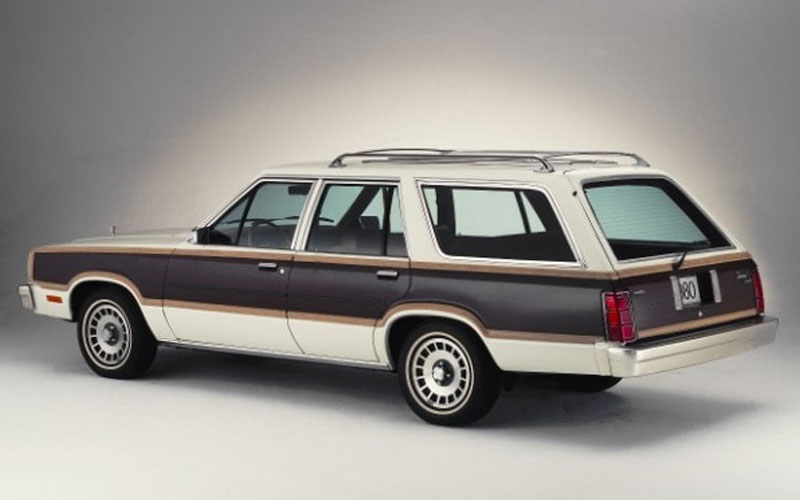
- The start of the new decade brought the end of one Ford station wagon. The 1980 Ford Pinto was retired, but Ford introduced North America to the 1981 Ford Escort, available as a three-door hatchback or five-door station wagon.
- The Escort was given an inline-4 that made 65 horsepower. That engine mated to a four or five-speed manual transmission, or with a three-speed automatic. Wood panels were still popular on station wagons, so an imitation woodgrain Squire package was offered on some of the 1981 Ford Escort wagon trims.
- Another new Ford wagon, the 1981 Ford Fairmont Futura five-door wagon, was put into production, too. The Fairmont Futura was first released in 1978 as a sedan or coupe, but the wagon was added with a 2.3L 4-cylinder making 88 horsepower with 118 lb-ft of torque.
- The 1983 Country Squire became a counterpart for the LTD Crown Victoria when Ford reorganized its full-size model lines. It also came with a 4.9L V8 with throttle-body fuel injection.
- Ford also introduced a separate 1983 Crown Victoria wagon without any woodgrain.
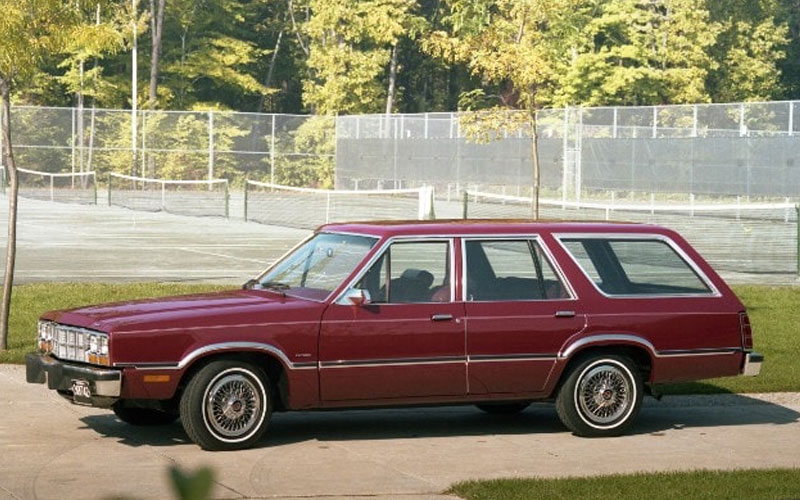
- A highly anticipated Ford Taurus was unveiled for the 1986 model year as sedans and station wagons. It was available in four trim levels: the L, MT-5, GL, and LX.
- A front-wheel drive vehicle, the Taurus had a V6 or an inline four-cylinder that were mated to a manual or automatic transmission.
- One of the things you’ll find out by clicking on our Ford Taurus Through the Years feature is that one of the reasons the Taurus impressed so many buyers is because it was a new Ford vehicle that could compete with Japanese automakers as being compact, reliable, and fuel-efficient.
- 57,625 of the 1986 Ford Taurus wagons were produced during that debut year. Ford sold 96,201 of the 1987 Ford Taurus station wagons the following year, but the MT-5 trim level was dropped due to poor sales.
- An update on the 1986 Country Squire included adding sequential multi-port fuel injection to the V8. Two years later, in the first external revision since the 1979 model, the 1988 Country Squire received a new front fascia. Inside, larger front seat head restraints were added.
1990s Ford Station Wagons
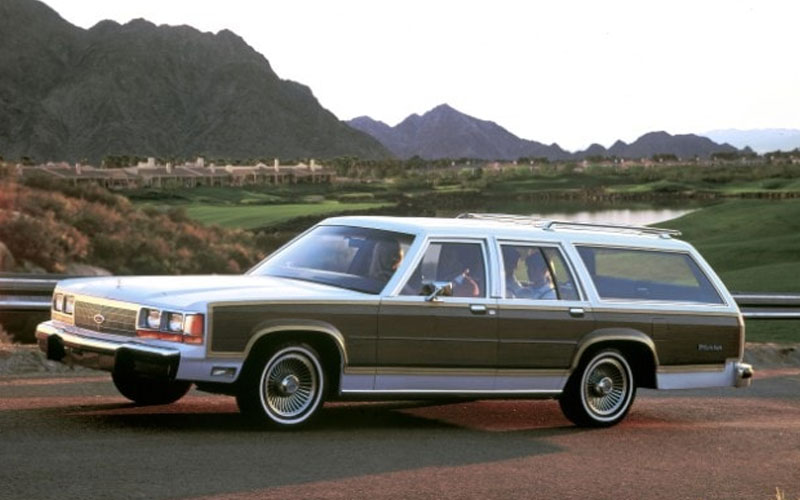
- The 1990 Country Squire dashboard added a driver-side airbag. Rear seats received three-point seatbelts. Then, for 1991 Country Squire models, a front turn signal and parking lamp lenses were changed from amber to clear.
- After eight generations, 40 years of production, and multiple counterparts, the Country Squire was discontinued. It ended as the slowest-selling Ford in North America with just 4,000 units produced.
- Consumer trends were shifting towards minivans, but the Ford Taurus was still offered as an 8-person station wagon. The 1991 Taurus replaced a 2.5L four-cylinder engine with a 140-horsepower 3.0L Vulcan V6. The LX trim was the only Taurus wagon that had a 3.8L Essex V6 that also made 140 horsepower.
- The Ford Escort started a second generation with the 1991 model. The little bit of restyling that had been done included implementing vertical taillamps.
- The 1993 Ford Escort was given 14-inch wheels instead of 13-inch wheels.
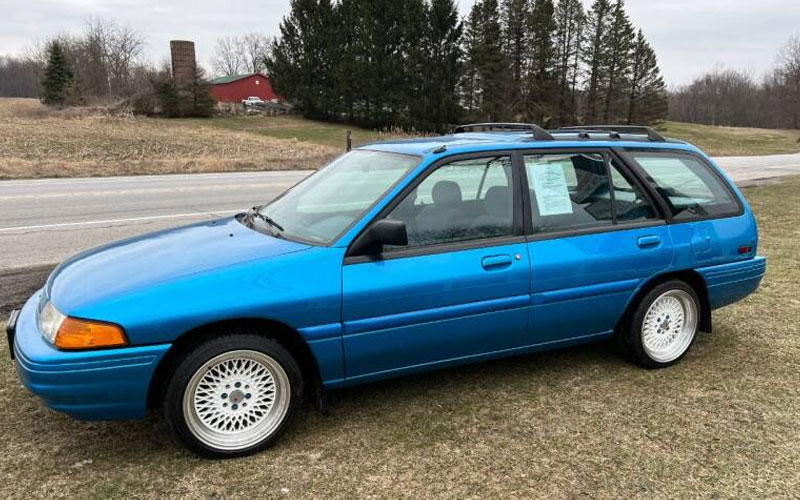
- The best-selling year of the second-generation Taurus was the 1993 Ford Taurus with 157,239 units sold.
- On February 9, 1995, Ford showcased the third generation of the Taurus. The 1996 Taurus sedan and station wagon were two of the most anticipated new cars of the year. It shared the same doors as the Mercury Sable.
- The 1996 Taurus had upscale features like chrome alloy wheels, Taurus badging, and chrome dual exhaust tips. Inside, the controls were reorganized and, in some cases, combined. The Ford Taurus wagons could fit up to six or eight people if it had a third-row bench.
- A restyled third-generation 1998 Ford Escort added a coupe body style but dropped the hatchback. The Escort sedan and wagon remained mostly the same, powered but a 110-horespower straight-four engine.
- Styling of the 1998 Ford Escort wagon didn’t change too much, though it did include a new interior, reworked taillamps and reflectors, updated badging, and updated side-view mirrors, door handles, and an updated front fascia.
- The Ford Escort wagon was dropped from the Ford lineup after 1999.
2000s Ford Station Wagons
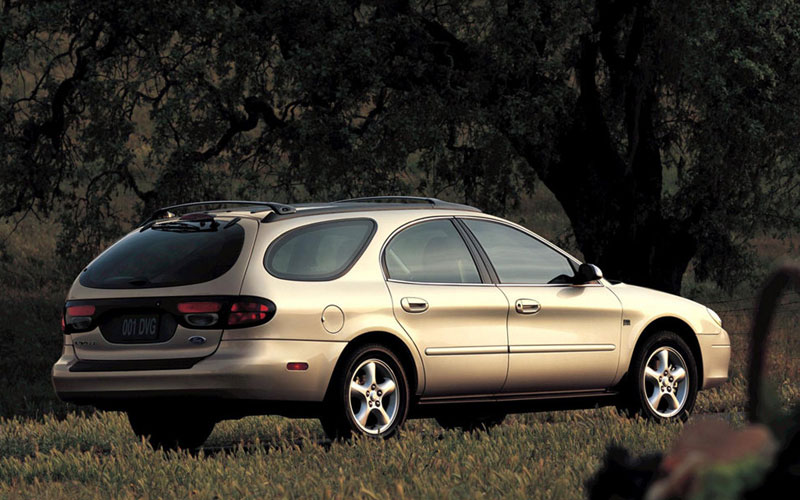
- Ford started the new millennium with a new 2000 Ford Taurus. The design gave the Taurus an edgier profile with sharper corners. The interior was mostly carried over from before, but it was reshaped to be less oval.
- Another wagon came along the same year. Ford started producing the 2000 Ford Focus as a 3-door hatchback, 4-door sedan, or 5-door wagon.
- The wagon version of the 2000 Focus had a 2.0L straight-four engine with 110 horsepower and 125 lb-ft of torque. The engine mated to a five or six-speed manual transmission or a four-speed automatic transmission.
- A few updates were made to the 2001 Ford Focus. A front armrest, power windows, a CD player, and a leather-wrapped steering wheel became standard on 2001 Focus wagons.
- A ZTW trim level was added to the 2002 Ford Focus station wagon. A power moonroof, a six-disc CD player, and larger cup-holders were a few of the other changes.
- The Ford Taurus wagon was discontinued in December 2004 for the most part, but, like other wagons, it was still sold to fleets in the United States.
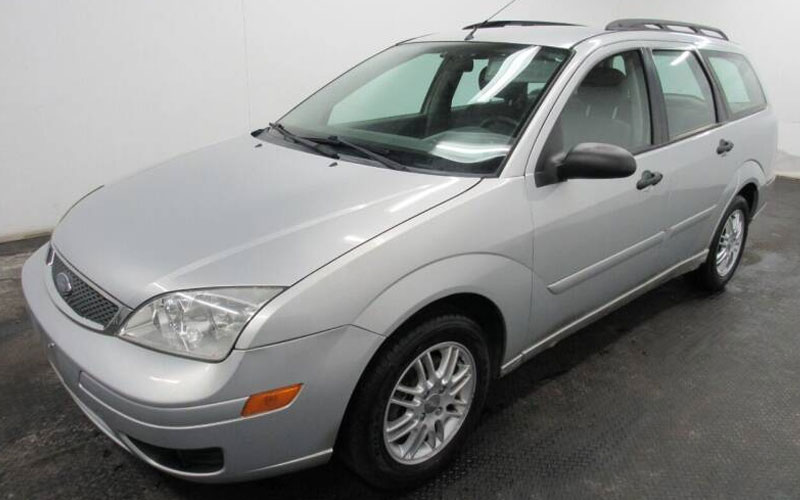
- Ford replaced the Taurus station wagon with the 2005 Ford Freestyle, a crossover SUV.
- The last remaining Ford station wagon, the 2005 Ford Focus, received a facelift. Engineering changes included a new 2.0L inline-4 engine with more horsepower than previous models. This front-wheel drive wagon used a five-speed manual transmission to make 136 horsepower with 133 lb-ft of torque.
- The 2005 Focus was given a new front bumper fascia, a harder steel alloy hood, optional space for sunglasses in the overhead console of the cabin, a dedicated space for a garage door opener, beverage holders in the front door pockets, and 15-inch steel wheels.
- More minor updates were made to the 2006 Ford Focus such as standard CD and MP3 capability on all models.
- For the 2007 Ford Focus models, new leather-trimmed sport seats were added. Additional colors, audio controls on the steering wheel, and better mileage ratings were a few additional upgrades.
- The last surviving Ford station wagon was the 2007 Focus, but Ford stopped production after that model year. While other automakers offer station wagons, there are none currently offered under the Ford insignia.


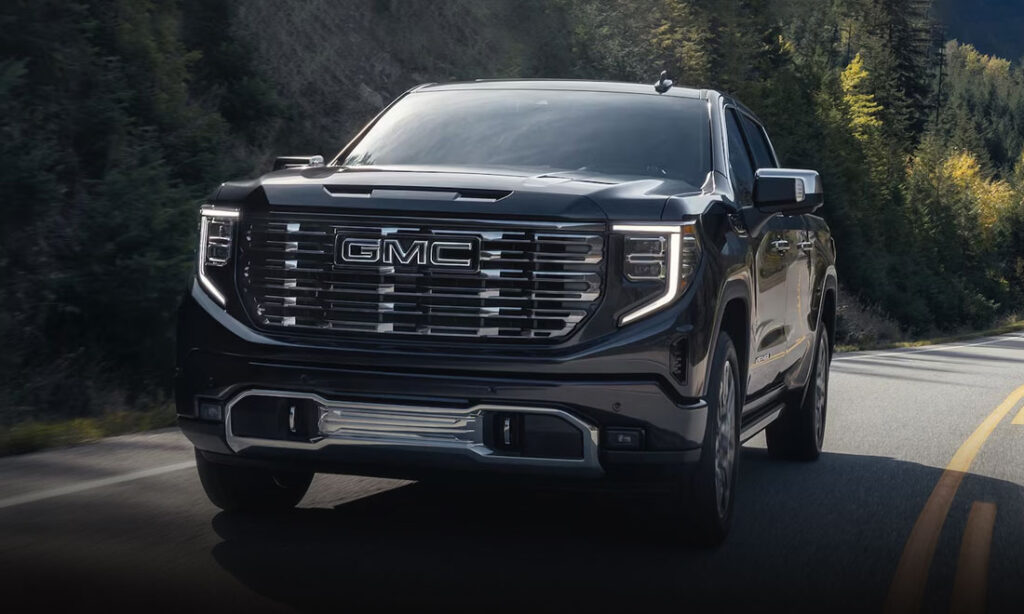
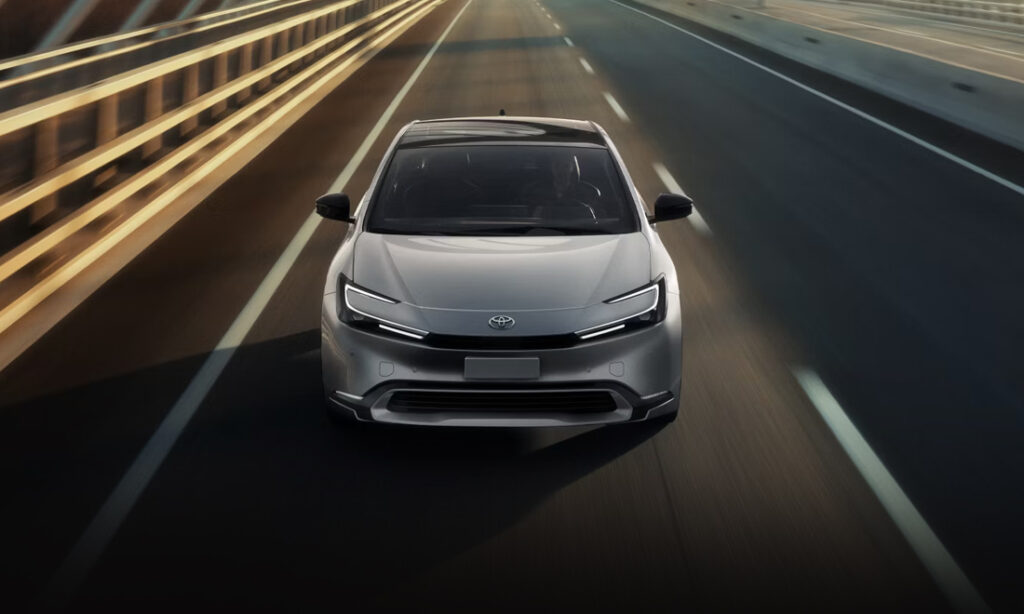
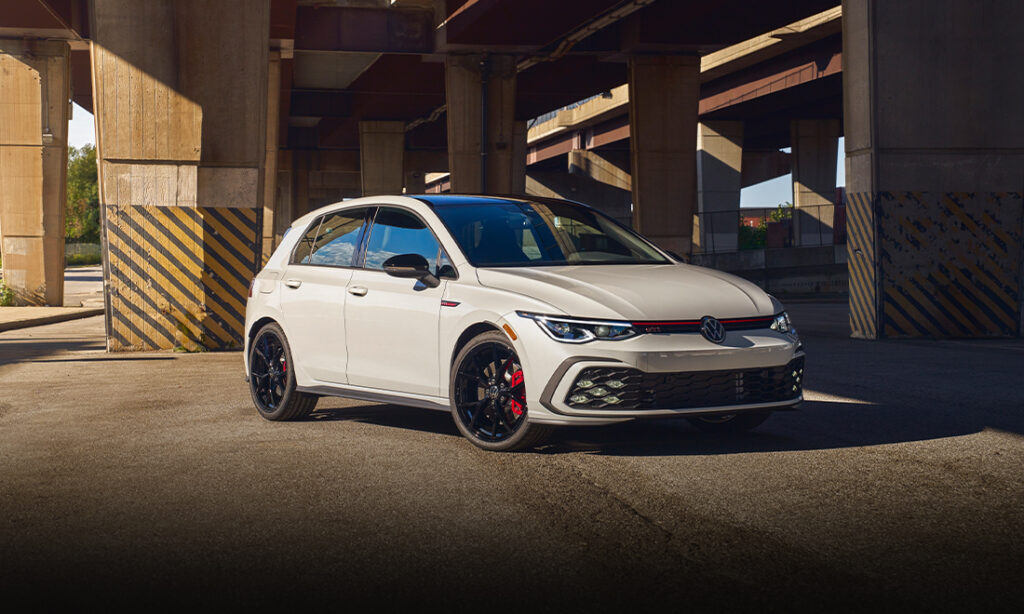
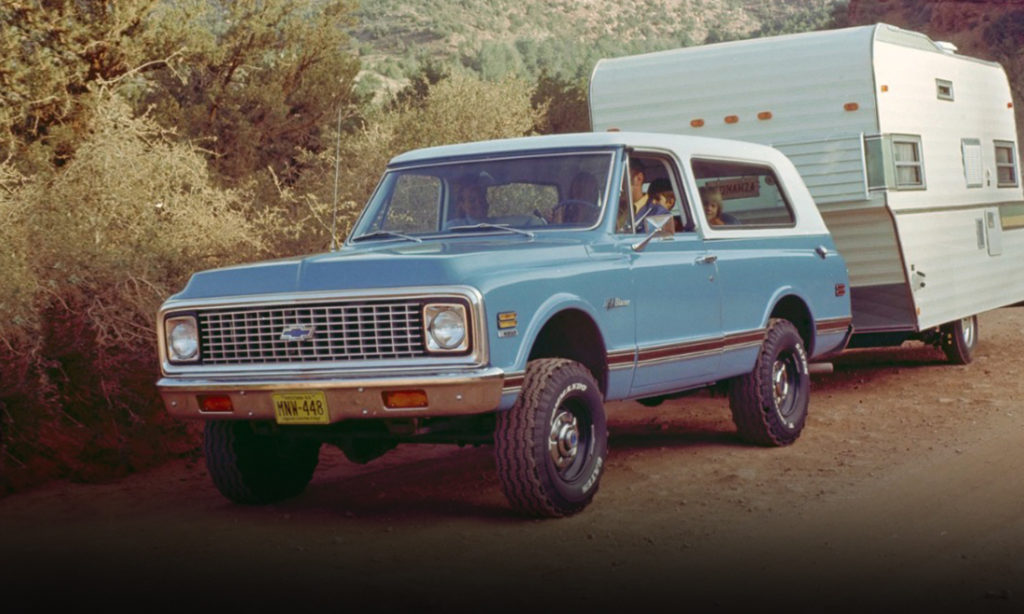
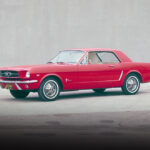




What a great article. Really enjoyed reading.
I didn’t see any reference to the downsized LTD Squire with the 3.8L V-6. I had a 1983 version. It was reliably unreliable. I’m pretty sure I paid for it three times, once to purchase it and at least twice that in repairs.